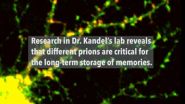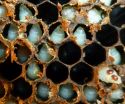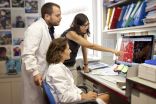(Press-News.org) Doughnuts, electric current and quantum physics - this will sound like a weird list of words to most people, but for Sebastian Huber it is a job description. ETH-professor Huber is a theoretical physicist who, for several years now, has focused his attention on so-called topological insulators, i.e., materials whose ability to conduct electric current originates in their topology.
The easiest way to understand what "topological" means in this context is to imagine how a doughnut can be turned into a coffee cup by pulling, stretching and moulding - but without cutting it. Topologically speaking, therefore, doughnuts and coffee cups are identical, and by applying the same principle to the quantum mechanical wave function of electrons in a solid one obtains the phenomenon of the topological insulator. This is advanced quantum physics, highly complex and far removed from everyday experience. Nevertheless, professor Huber and his collaborators have now managed to make these abstract ideas very concrete and even to come up with a possible application in engineering by cutting red tape, as it were, and involving colleagues from different disciplines all the way through the ETH.
From quanta to mechanics
In the beginning, Sebastian Huber asked a simple question: is it possible to apply the principle of a topological insulator to mechanical systems? Normally, quantum physics and mechanics are two separate worlds. In the quantum world particles can "tunnel" through barriers and reinforce or cancel each other as waves, whereas everyday mechanics deals with falling bodies or the structural analysis of bridges. Huber and his colleagues realized, however, that the mathematical formulas describing the quantum properties of a topological insulator can be rearranged to look exactly like those of a well-known mechanical system - an array of swinging pendulums.
In particular, just like their quantum mechanical counterparts the mechanical formulas predicted so-called edge states. In such states an electric current (or, in the case of pendulums, a mechanical vibration) flows along the edges of the material, while inside the system nothing happens. "From a theoretical point of view that was a beautiful result", says Huber, "but, of course, it is easier to convince people if you also show it in practice."
No sooner said than done, together with technicians at the ETH Huber and his student built a mechanical model consisting of 270 pendulums that are arranged in a rectangular lattice and connected by small springs. Two of those pendulums can be mechanically excited, meaning that they can be shaken back and forth with a particular frequency and strength. Little by little, the spring couplings cause the other pendulums to start swinging as well. Eventually, for a particular excitation frequency the physicists saw what they had been hoping for: the pendulums inside the rectangle stood still, whereas those along the edge vibrated rhythmically, causing a "wave" to flow around the rectangle. In other words, the coupled pendulums did, indeed, behave just like a topological insulator.
Robotic arms and lenses for sound
What started out as a pipe dream and a nice gimmick for professor Huber could soon become a useful tool. The mechanical edge states of the coupled pendulums, it turns out, are so robust - "topologically protected", in technical language - that they persist if the array of pendulums is disordered and even if a part of the rectangle is removed. Such properties would be interesting, for instance, in sound and vibration insulation, which is important in various areas such as industrial production, where robot arms have to place objects precisely and without jittering. Moreover, one can imagine materials that convey sound in one direction only, or others that focus sound like a lens.
"Such applications are very challenging, but still realistic", says Chiara Daraio, ETH-professor for mechanics and materials. Of course, the mechanical systems would first have to shrink considerably - Huber's pendulums are, after all, half a metre long and weigh half a kilo. The engineers are already building a new device that works without pendulums and that will only be a few centimetres in size.
INFORMATION:
Literature reference
Süsstrunk R, Huber SD: Observation of phononic helical edge states in a
mechanical topological insulator. Science 2015, 349: 47-50, doi: 10.1126/science.aab0239
Hamilton, ON (July 2, 2015) - Two new studies led by researchers from the Farncombe Family Digestive Health Research Institute at McMaster University show that transplantation of fecal matter may be a useful tool in the fight against ulcerative colitis (UC).
Ulcerative colitis is a chronic, debilitating inflammatory bowel condition characterized by symptoms including bloody stools, diarrhea, abdominal pain, weight loss and malnutrition. It results from the development of abnormal immune responses to the normal bacteria in the digestive tract. It is difficult to treat ...
NEW YORK, NY (July 2, 2015)--Research from Eric Kandel's lab at Columbia University Medical Center (CUMC) has uncovered further evidence of a system in the brain that persistently maintains memories for long periods of time. And paradoxically, it works in the same way as mechanisms that cause mad cow disease, kuru, and other degenerative brain diseases.
In four papers published in Neuron and Cell Reports, Dr. Kandel's laboratory show how prion-like proteins - similar to the prions behind mad cow disease in cattle and Creutzfeld-Jakob disease in humans - are critical ...
Think you're a foodie? Adventurous eaters, known as "foodies," are often associated with indulgence and excess. However, a new Cornell Food and Brand Lab study shows just the opposite -adventurous eaters weigh less and may be healthier than their less-adventurous counterparts.
The nationwide U.S. survey of 502 women showed that those who had eaten the widest variety of uncommon foods -- including seitan, beef tongue, Kimchi, rabbit, and polenta-- also rated themselves as healthier eaters, more physically active, and more concerned with the healthfulness of their food ...
An infestation of speck-sized Varroa destructor mites can wipe out an entire colony of honey bees in 2-3 years if left untreated. Pesticides help beekeepers rid their hives of these parasitic arthropods, which feed on the blood-like liquid inside of their hosts and lay their eggs on larvae, but mite populations become resistant to the chemicals over time.
While exploring plant-based alternatives to control Varroa mites, Chinese bioagricultural and Japanese cell physiological labs saw that certain tick repellents repress mites from finding their honey bee hosts. In a ...
To observe the brain in action, scientists and physicians use imaging techniques, among which functional magnetic resonance imaging (fMRI) is the best known. These techniques are not based on direct observations of electric impulses from activated neurons, but on one of their consequences. Indeed, this stimulation triggers physiological modifications in the activated cerebral region, changes that become visible by imaging. Until now, it was believed that these differences were only due to modifications of the blood influx towards the cells. By using intrinsic optical signals ...
Healthy people given the serotonin-enhancing antidepressant citalopram were willing to pay almost twice as much to prevent harm to themselves or others than those given placebo drugs in a moral decision-making experiment at UCL. In contrast, the dopamine-boosting Parkinson's drug levodopa made healthy people more selfish, eliminating an altruistic tendency to prefer harming themselves over others. The study was a double-blind randomised controlled trial and the results are published in Current Biology.
The research provides insight into the neural basis of clinical disorders ...
BETHESDA, MD - The American Society of Human Genetics (ASHG) Workgroup on Pediatric Genetic and Genomic Testing has issued a position statement on Points to Consider: Ethical, Legal, and Psychosocial Implications of Genetic Testing in Children and Adolescents. Published today in The American Journal of Human Genetics, the statement aims to guide approaches to genetic testing for children in the research and clinical contexts. It also serves as an update to the Society's 1995 statement of the same title, which was issued jointly with the American College of Medical Genetics.
"Twenty ...
Idiopathic pulmonary fibrosis (IPF) causes a gradual loss of respiratory capacity and can be lethal within a few years. The cause is unknown, although it can be attributed to a combination of genetics and the environment. A team of researchers from the Spanish National Cancer Research Centre (CNIO) have now discovered that telomeres, the structures that protect the chromosomes, are at the origin of pulmonary fibrosis. This is the first time that telomere damage has been identified as a cause of the disease. This finding opens up new avenues for the development of therapies ...
A mutation found in most melanomas rewires cancer cells' metabolism, making them dependent on a ketogenesis enzyme, researchers at Winship Cancer Institute of Emory University have discovered.
The finding points to possible strategies for countering resistance to existing drugs that target the B-raf V600E mutation, or potential alternatives to those drugs. It may also explain why the V600E mutation in particular is so common in melanomas.
The results are scheduled for publication in Molecular Cell.
The growth-promoting V600E mutation in the gene B-raf is present in ...
The first comprehensive analysis of the woolly mammoth genome reveals extensive genetic changes that allowed mammoths to adapt to life in the arctic. Mammoth genes that differed from their counterparts in elephants played roles in skin and hair development, fat metabolism, insulin signaling and numerous other traits. Genes linked to physical traits such as skull shape, small ears and short tails were also identified. As a test of function, a mammoth gene involved in temperature sensation was resurrected in the laboratory and its protein product characterized.
The study, ...





